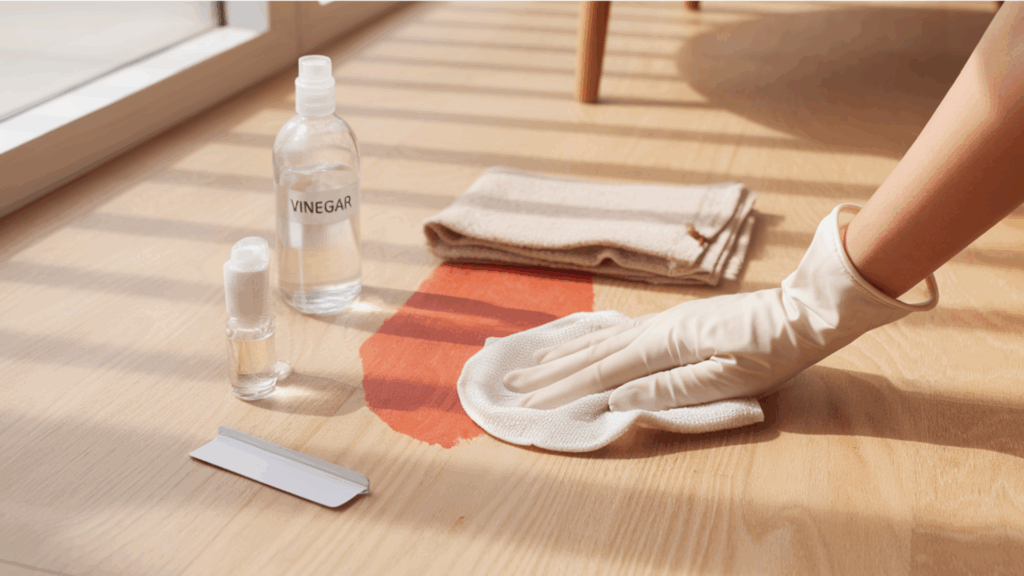Have you ever had paint spill on your laminate floor? That small splash can feel like a problem when it happens. I’ve been there! What do you do first?
How can you clean it without ruining your floor? Laminate floors look great, but they need special care when cleaning up messes like paint.
The good news is you can fix this without calling a professional. Over the years, I’ve tried many methods; some have worked well, while others have not yielded good results.
Through trial and error, I’ve compiled this guide to assist you with your paint cleanup process.
I’ll walk you through what works and what doesn’t so you can get your floors looking clean again with the right approach and tools.
That paint spot doesn’t have to be permanent!
Understanding Laminate Floors
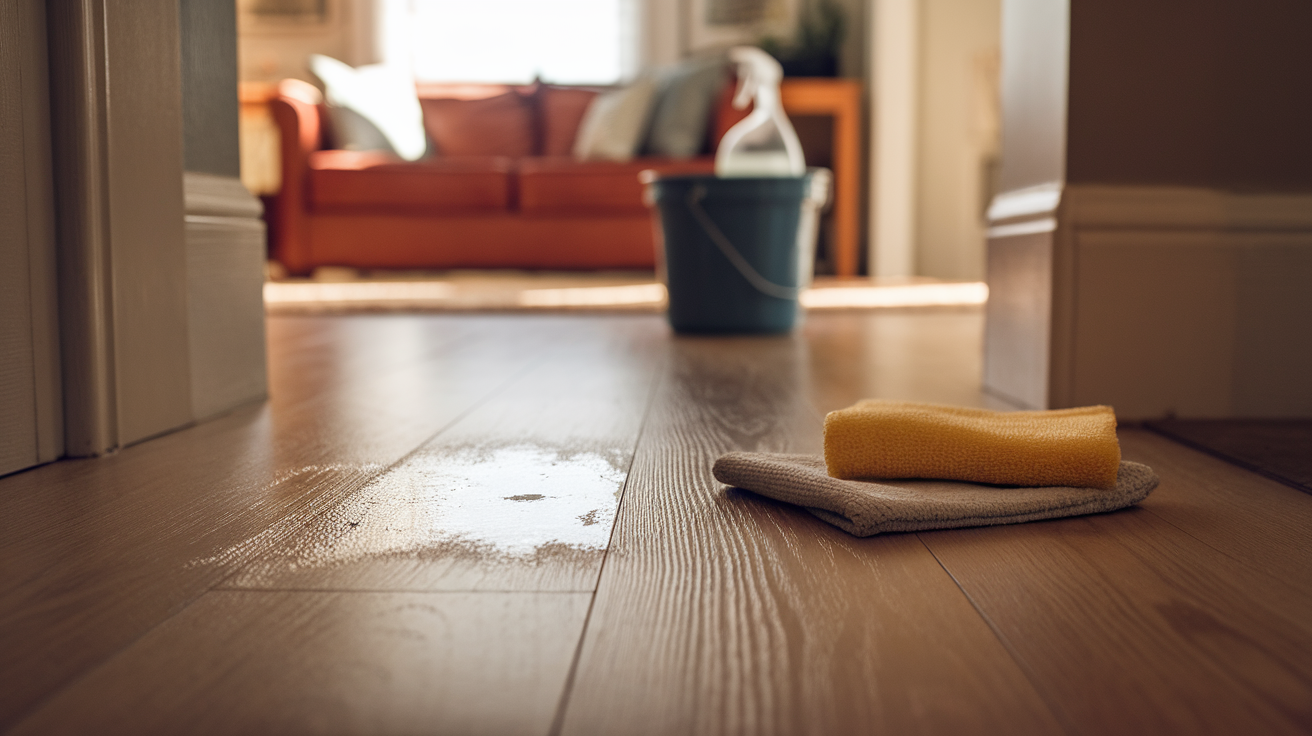
Laminate flooring gives you the nice look of wood without the high price.
I spent months picking the perfect style for my living room, only to worry every time I had to clean it. Why? Because laminate isn’t as tough as it looks.
It has a clear top layer that scratches pretty easily. I found this out when I used a rough sponge on a dried paint spot in my hallway.
The paint came off, but so did some of the shine from my floor. The mark stayed there, reminding me to be more careful next time.
The floor might look solid, but it needs gentle care.
When paint falls on it, we need to remove it without harming this protective coating. Before I knew better, I tried scrubbing too hard and learned my lesson the hard way.
Why Paint Is Hard to Remove from Laminate Flooring
- Laminate seams aren’t sealed like tile grout, so moisture or harsh cleaners can seep in and cause swelling or bubbling at the edges.
- Scraping dried paint with metal tools can scratch the top protective layer. Once that layer is damaged, you often need to replace the whole board.
- Textured surfaces trap paint in small grooves. Even if paint looks like it’s just on top, it can bond more deeply in these crevices.
- Paint dries fast and bonds firmly to laminate, especially if left too long. This makes it much harder to remove later.
- Paint is visually noticeable on laminate floors. Even tiny drops reflect light differently, drawing attention and disrupting the clean look.
- Delaying cleanup leads to permanent marks or staining. The longer paint stays on the surface, the more likely it is to damage the finish.
- Acting quickly and gently is the best approach. Patience and the right method can help you clean without damaging your floor.
Removing Paint: Quick Tips That Work
Quick action makes a big difference. If the paint is still wet, you might be able to wipe it up with just a damp cloth.
But even if it’s dried, don’t worry, there are still plenty of ways to handle it. Before doing anything, try to figure out what type of paint you’re dealing with.
This will help you pick the right method without wasting time on things that won’t work. I’ve found that testing a small area first always pays off in the end.
Remember that some methods work better on fresh paint while others are needed for paint that’s been there a while. It’s worth trying the gentlest method first and moving to stronger options only if needed.
Identifying the Paint

Water-based paints like latex or acrylic craft paints are usually the easiest to clean.
Oil-based paints are tougher to remove.
If you’re not sure what type of paint you have, try this simple test: put a drop of water on the edge of the paint spot.
If it starts to soften or smear, it’s probably water-based. If the water sits on top without affecting the paint, it’s likely oil-based.
Tools and Materials Needed to Remove Paint
Before starting, gather all the necessary items:
- Soft cloths or paper towels
- Mild dish soap
- Warm water
- Spray bottle
- Plain white vinegar
- Nail polish remover
- Rubbing alcohol
- Plastic scraper or old credit card
- Window cleaner
Having these items ready saved me time and energy.
Instead of running around looking for supplies while the paint dried, having everything at hand helped me tackle the problem quicker.
Solutions and Steps Based on Paint Type
1. For Water-Based Paint (Use: Vinegar Solution)
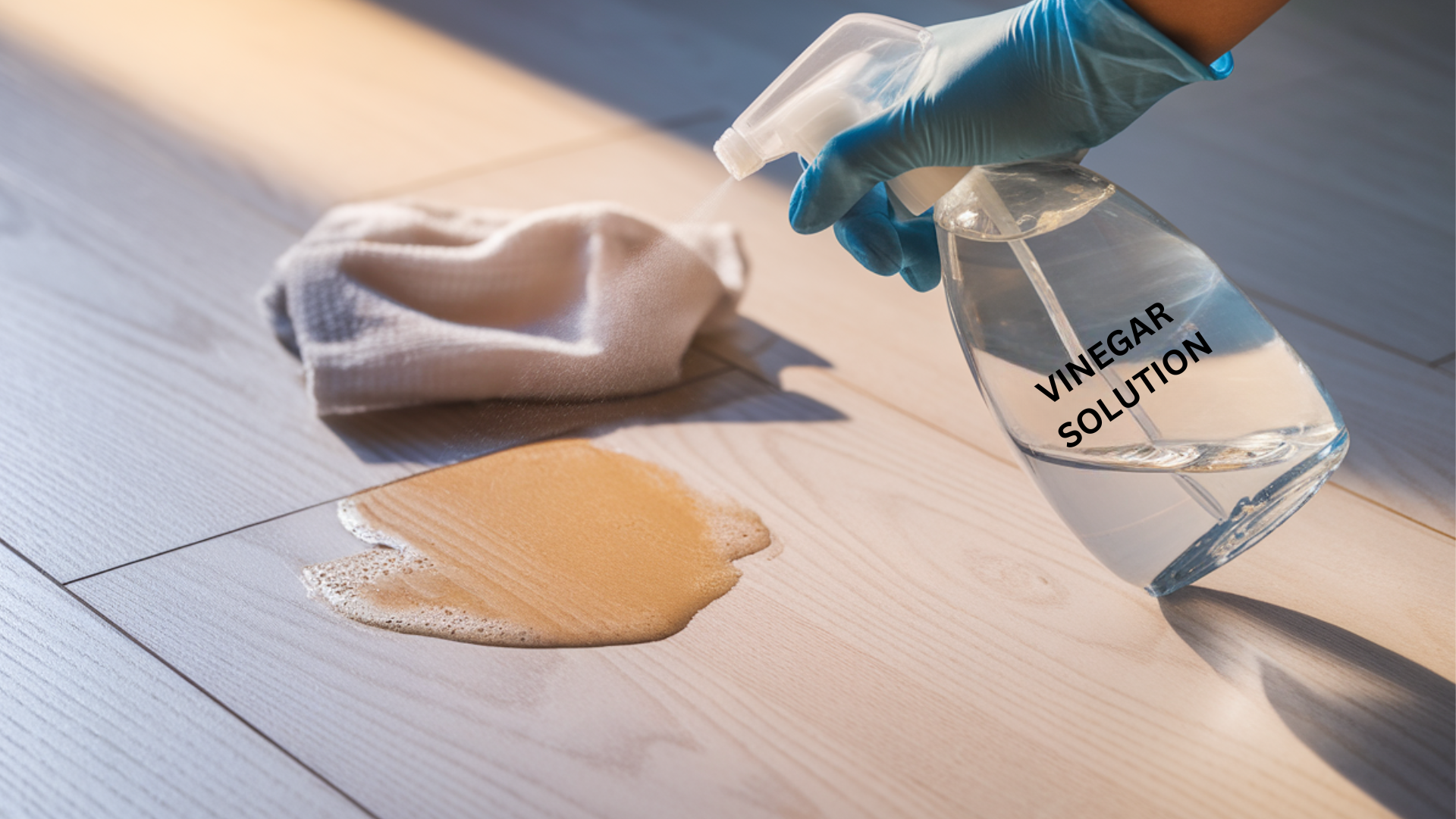
Water-based paints respond well to a simple homemade solution of one part white vinegar, two parts warm water, and a small squirt of dish soap.
This mild acid mix helps break down water-based paint without harming your floor.
How to use:
- Spray the solution directly on the paint spot
- Let it sit for 3-5 minutes to soften the paint
- Wipe gently with a soft cloth using circular motions
- Rinse with a clean, damp cloth
- Dry the area completely with a towel
2. For Oil-Based Paint (Use: Nail Polish Remover)
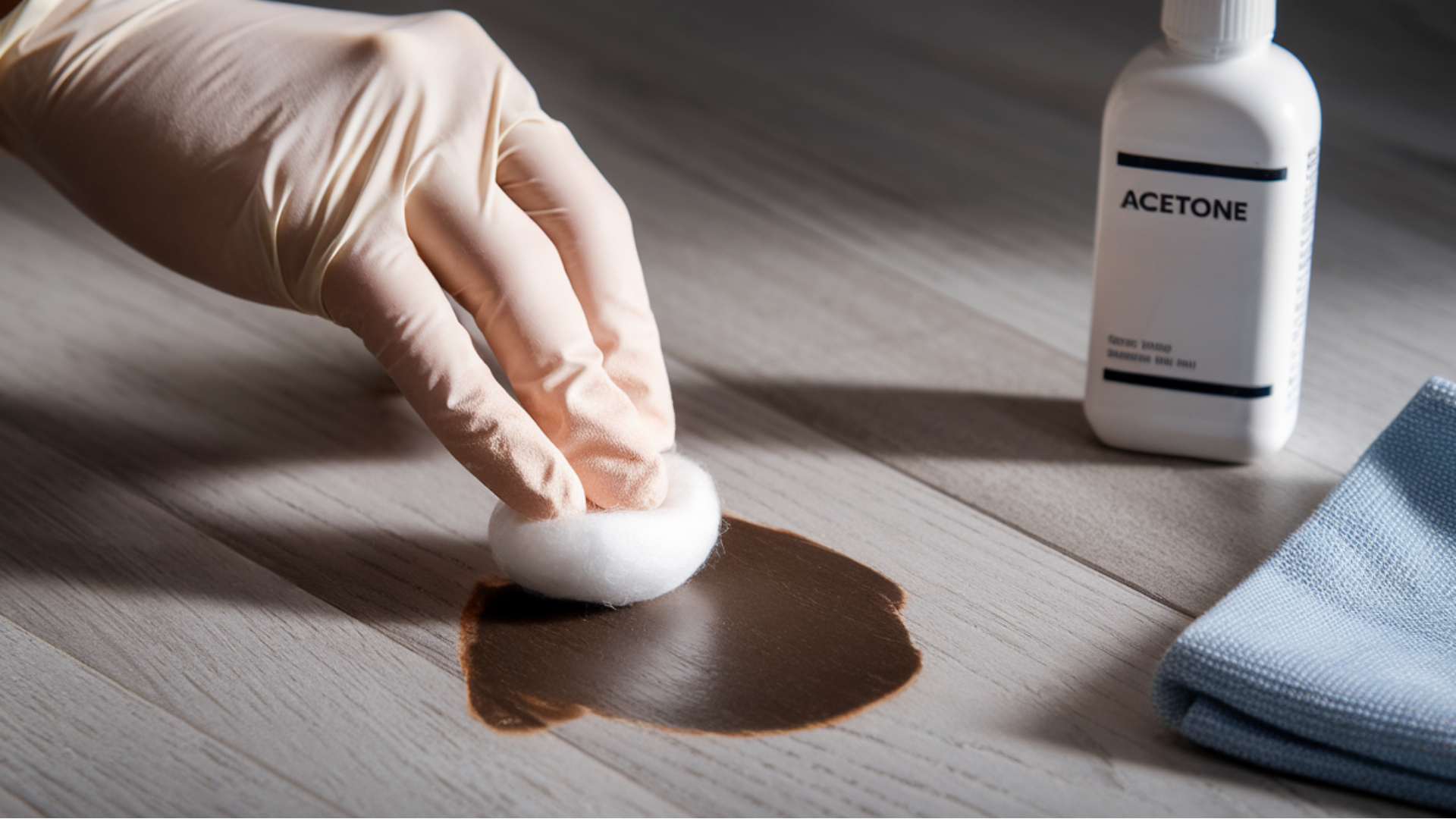
Oil-based paints need nail polish remover with acetone.
The acetone breaks down the tough oil bonds that make these paints so hard to remove with just water.
How to use:
- Test on a hidden area of the floor first
- Apply a small amount to a cotton ball
- Press gently on the paint spot for 30 seconds
- Wipe away the loosened paint without rubbing hard
- Clean the area immediately with a damp cloth to remove all acetone
- Dry thoroughly with a clean cloth
3. For Small Fresh Paint Spots (Use: Window Cleaner)

Window cleaner works well for minor spots due to its mild solvent properties. It’s gentler than acetone but still effective on fresh paint.
How to use:
- Spray directly onto the paint spot (avoid soaking the floor)
- Wait about 60 seconds
- Wipe with a soft cloth using light pressure
- Rinse with a clean, slightly damp cloth
- Dry the area completely
4. For Stubborn Dried Paint (Use: Alcohol-Vinegar Mix)
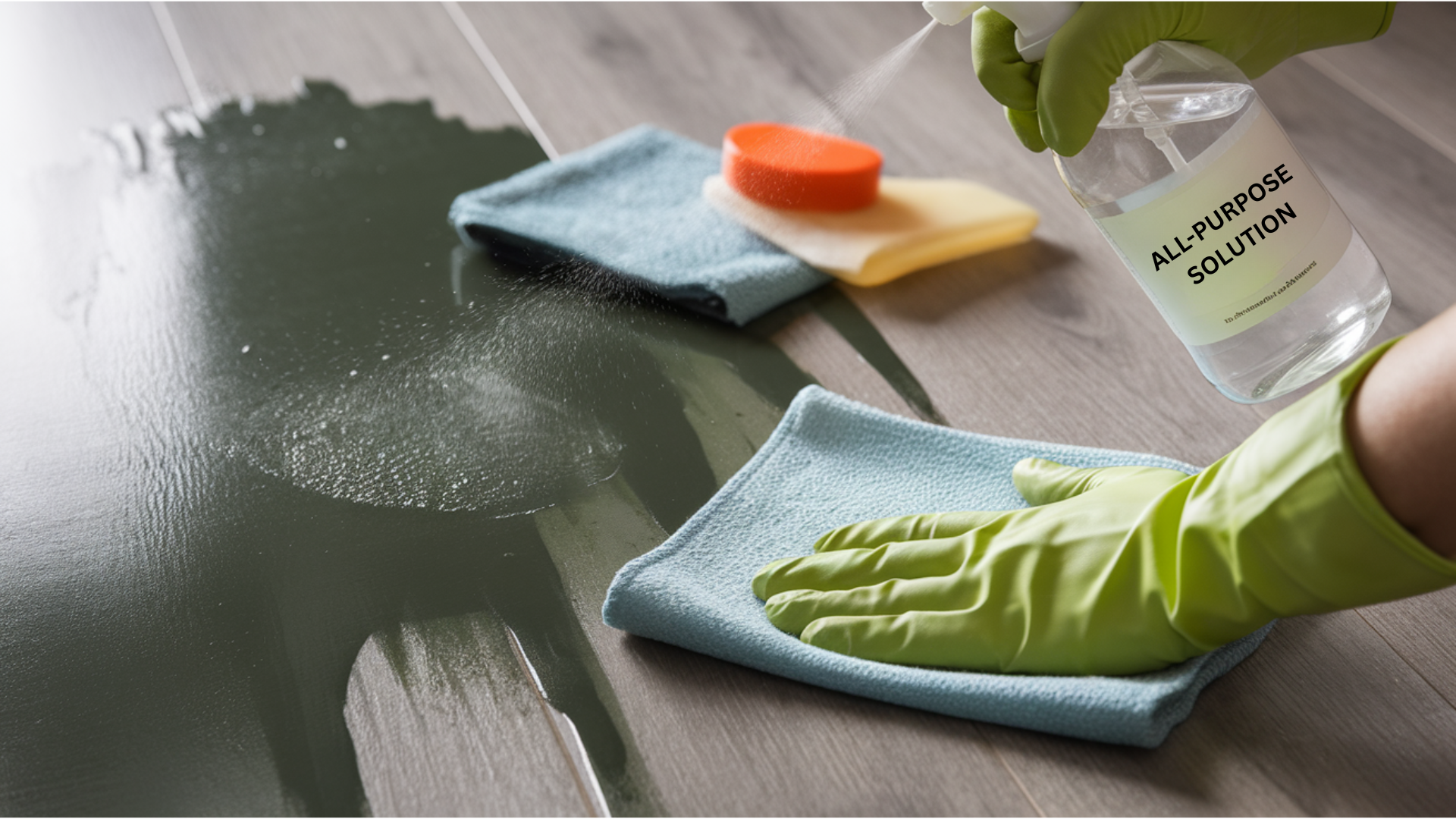
The all-purpose solution combines equal parts rubbing alcohol and vinegar with a few drops of dish soap.
The alcohol works as a stronger solvent while the vinegar helps lift the paint.
How to use:
- Mix in a spray bottle and shake well
- Spray directly on the dried paint
- Let it sit for 2-3 minutes (don’t let it dry on the floor)
- For extra-stubborn spots, place a soaked cloth on the area for 5 minutes
- Wipe clean and rinse with a damp cloth
- Dry completely to prevent water damage
5. For Paint That Won’t Budge (Use: Combined Approach)
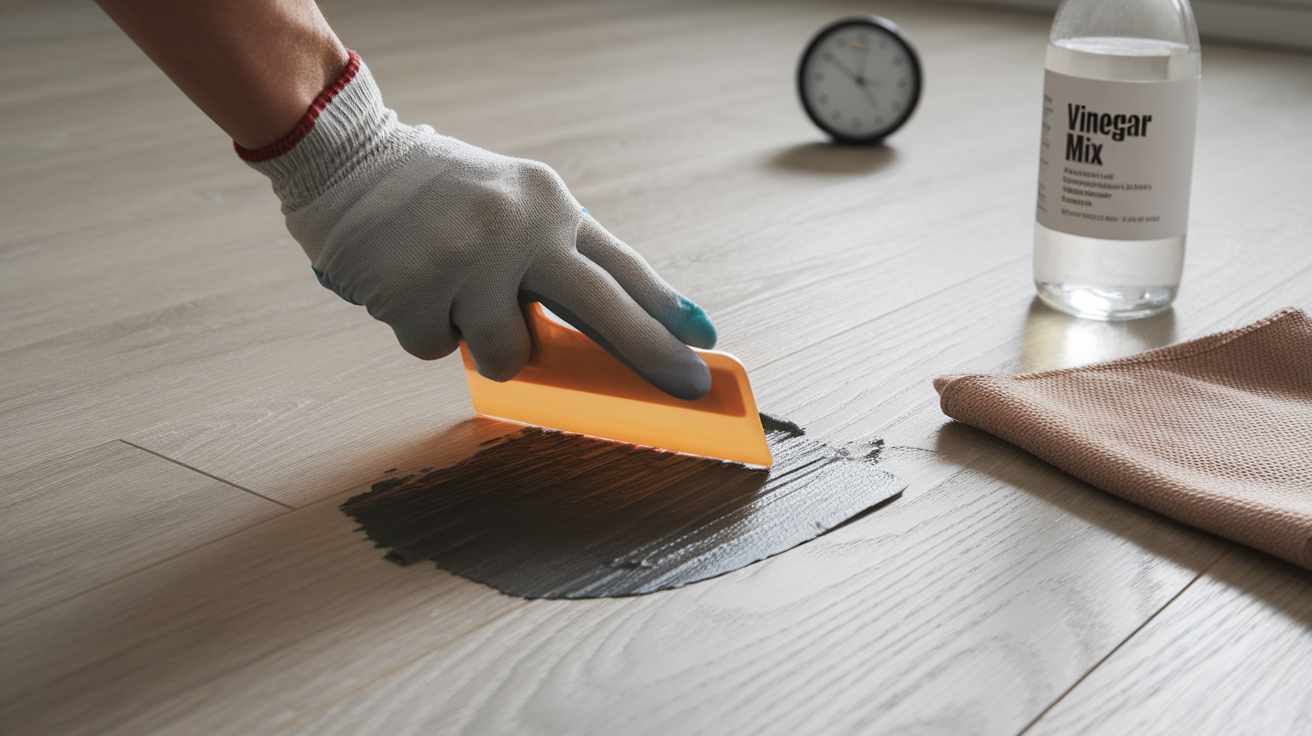
When paint is especially stubborn, try this stepped approach with any of the above solutions:
- Use a plastic scraper or an old credit card to gently lift the edge of dried paint
- Apply your chosen solution to what remains
- Let the solution work for a few minutes
- Gently wipe or lift away, working from the outside in
- Rinse and dry thoroughly
What Not to Do?
When removing paint from laminate floors, using the wrong tools or products can cause permanent damage. Learn from common mistakes and stick with safe, gentle methods.
- Don’t use metal tools or rough scrubbers: They can scratch the surface and leave visible marks. I once used a metal putty knife, and those scratches still catch the light today.
- Avoid bleach or harsh chemical cleaners: Even on light-colored laminate, bleach can cause fading and discoloration. I tried bleach on white paint once and ended up with a dull, blotchy patch.
- Skip steam cleaners: High heat and moisture can cause laminate to buckle or peel.
- Never soak the area: Excessive water can seep into seams, leading to swelling or damage over time.
Precautions That Should Be Taken
Before you start cleaning paint off laminate floors, it’s important to protect both your flooring and yourself. A few simple steps can prevent bigger issues down the line.
- Test cleaners on a hidden spot first: Try under furniture or behind a door to check for discoloration or dullness.
(I once skipped this and ended up with a faded patch near my kitchen.) - Wear gloves while cleaning: Products like rubbing alcohol or nail polish remover can be harsh on your skin.
- Ensure good ventilation: Keep windows open or run a fan to reduce strong fumes from cleaning agents.
- Never leave your floor wet: Moisture can seep into seams and cause warping.
(I keep a pile of dry cloths nearby to wipe up any leftover dampness right away.)
Conclusion
Paint spills happen to everyone.
They’re annoying when they occur, but they don’t have to stay on your floor forever. With the right tools and a bit of patience, you can clean them up without harming your laminate.
I’ve made my share of mistakes and found better ways to fix them, so you don’t have to learn the hard way. This guide comes from real problems I’ve faced and solved.
The key points to remember are to act quickly when possible, know what type of paint you’re dealing with, use the right cleaning method, and be gentle with your floor.
With these steps, you can remove the paint and keep your laminate looking clean and smooth.
Next time you see a paint drip hit your floor, you’ll know exactly what to do without panic.
Your floor will thank you, and you’ll feel good about handling the problem yourself.

